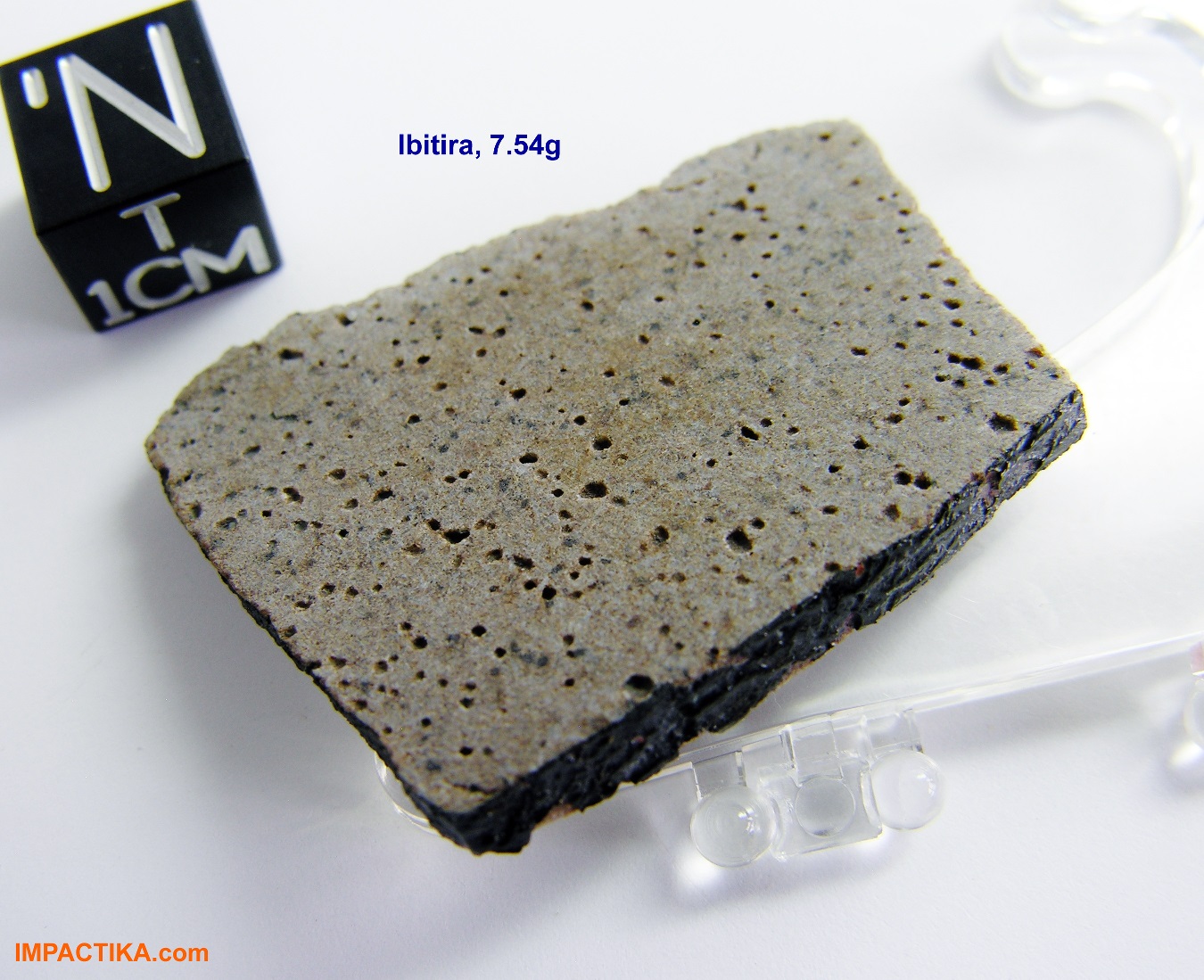|
|

|
7.54 grams. Eucrite-mmict
TKW 2.5 kg. Observed fall 30 June 1957, Minas Gerais, Brazil.
Anne writes:
Unusual Monomict-Eucrite with tiny vugs.
From the MetBul:
The fireball passed northwestward and accompanied with a noise like the reverberation of thunder has been observed. This phenomenon has been marked in the radius about 160 km. At the end point of the trajectory the fireball was broken up and disappeared at the height about 10 or 12 km above the earth’s surface. The meteorite was found near the predicted point of the fall, in the village Ibitira. It lay in a hole in the ground about 25 cm deep and 20 cm in diameter. The meteorite has a brilliant black crust, and a light brown. It was brought to the Institute of Technological Researches (Belo Horizonte). Preliminary chemical analysis show the presence, in decreasing order of abundance, of silicon, magnesium, iron, aluminum, calcium, chromium, and titanium. Spectroscopic examination reveals lines of sulphur and manganese, but there were no signs of sodium, nickel and cobalt.
Source: the article: Vincent Menezes, "A Probable Meteorite Fall in Brazil" - Sky and Telescope, 1957, v. XVII, No 1, 10.
Visit my Web Site |
Click to view larger photos
#1
|
Found at the arrow (green or red) on the map below
|
|
| |
Graham Macleod
5/15/2016 3:03:55 AM |
WOW Anne,
This is another new one for me and the description Bob gives is great reading!
A really interesting history and the nlack crust around the edge is a bit like an IMB crust?
Thanks. |
Bob Verish
5/14/2016 1:48:06 AM |
Re: your question John, from what I have read Ibitira is considered to be a low-shock basalt. I have a part-slice similar in size to Anne's. I have examined the vesicles with a microscope and have found several to contain a solitary euhedral crystal. None contained any melt-glass. My best guess: that the crystals formed slowly in the same manner as herkimer quartz, red beryl, garnets, and topaz in well-known terrestrial vesicular rocks.
I have links (which are not permitted here) to images of these minute crystals in vesicles in my Ibitira specimen that I took 19 years ago (taken with my very first digital camera) so the resolution is poor, but if still interested, you have my email address.
|
Bob Verish
5/13/2016 8:17:14 PM |
Re: your question John, from what I have read Ibitira is considered to be a low-shock basalt. I have a part-slice similar in size to Anne's. I have examined the vesicles with a microscope and have found several to contain a solitary euhedral crystal. None contained any melt-glass. My best guess: that the crystals formed slowly in the same manner as herkimer quartz, red beryl, garnets, and topaz in well-known terrestrial vesicular rocks.
I have links (which are not permitted here) to images of these minute crystals in vesicles in my Ibitira specimen that I took 19 years ago (taken with my very first digital camera) so the resolution is poor, but if still interested, you have my email address.
|
John Divelbiss
5/13/2016 4:58:38 PM |
the diogenite I spoke of with vugs is NWA 8744 sold by The BK and Greg Hupe. |
Anne Black
5/13/2016 2:27:57 PM |
We understand John. No bugs in space. And to me Ibitira looks like it was eaten by worms, rather than bugs. :-) |
John Divelbiss
5/13/2016 8:49:15 AM |
I'll take answers about asteroidal vugs or bugs. :) (dang keys are side-by-side) |
John Divelbiss
5/13/2016 7:18:04 AM |
After seeing a recent NWA diogenite with similar areas of impact created small vugs. Is there any thought now that Ibitira's bugs may have been created by impact(s), or is it still thought that it's vugs came from the geology of the source planetoid/asteroid? |
MexicoDoug
5/13/2016 12:32:15 AM |
What a delicious slice of Havarti with caraway! Does it come with a glass of wine? ;-) |
| |
|